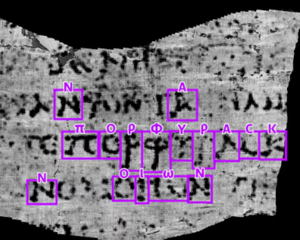In the spring of 2023, as he drove to his SpaceX internship in Starbase, Texas, a college student named Luke Farritor found himself riveted by a podcast.
2023年春天,一位名叫盧克·法里托的大學生開車去德克薩斯州星際基地的SpaceX實習時,被一個播客節目深深吸引了。
The hosts were describing a competition with an audacious goal: to read a 2,000-year-old scroll without physically unrolling it.
播客主持人正在描述一個目標十分大膽的比賽:在不展開卷軸的情況下讀出一個有著2000年歷史的卷軸上的文字。
The manuscript was part of a cache of papyrus rolls buried and carbonized by the eruption of Mount Vesuvius, which wiped out the Roman cities of Pompeii and Herculaneum in A.D. 79.
這份手稿是一批紙莎草卷軸的一部分,這些卷軸在維蘇威火山噴發后被埋藏并已碳化,公元79年的這次火山噴發摧毀了羅馬城市龐貝和赫庫蘭尼姆。
If opened by hand, the scrolls would crumble into pieces, obliterating whatever message they contain.
假如手工打開這些卷軸,它們就會碎成渣渣,卷軸上所包含的任何信息便會灰飛煙滅。
Competitors who found a way to see inside using machine learning could share more than one million dollars in prize money.
利用機器學習找到閱讀卷軸文字方法的參賽者可以分享超過100萬美元的獎金。
"I was like, Holy cow, I have to work on this," says Farritor, now 22. "A lot of things about it were really compelling, the biggest one being that you're going to potentially discover a new library from the ancient world, and that's a big deal."
現年22歲的法里托說:“我當時就想,天哪,我必須參與這個項目。這件事有很多吸引人的地方,最吸引人之處在于你有可能會發現一個來自古代世界的新圖書館,這可是一件了不起的事。”
While he focused on space travel in his day job, Farritor, a computer science major, devoted his nights and weekends to the Vesuvius Challenge -- something akin to time travel.
主修計算機科學的法里托,把自己的每個夜晚和周末都投入到維蘇威挑戰賽中--這有點像時間旅行。

What did this scroll, from a Herculaneum villa believed to have been owned by the father-in-law of Julius Caesar, have to say?
這份來自赫庫蘭尼姆別墅的卷軸據信曾屬于凱撒大帝的岳父,它究竟說了些什么呢?
To find out, contestants would have to develop their own programs that could interpret existing 3D scans of the coiled scroll and chart subtle physical variations to detect writing on the charred material.
為找出答案,參賽者必須開發自己的程序,解釋卷軸的3D掃描圖,描繪出微妙的物理變化,識別燒焦材料上的文字。
Farritor first studied CT scans of sections where the carbon-based ink was imperceptible against the carbonized papyrus.
法里托首先研究了CT掃描圖像中的部分區域,但在這些區域中,碳基墨跡在碳化的紙莎草上難以識別。
Another competitor in the contest, which rewarded participants with cash prizes for sharing early results, had observed "crackle" patterns resembling dried mud but which could indicate the presence of ink.
另一名參賽者--該比賽為分享早期結果的參與者提供現金獎勵—-觀察到類似干泥的“裂紋”模式,這可能表明墨水的存在。
So Farritor trained a machine learning model to home in on the crackle texture.
于是法里托訓練了一個機器學習模型,專注于研究裂紋紋理。
Late one Saturday night, back at the University of Nebraska, Farritor got word that a new section of the scroll had been uploaded for competitors.
一個周六的深夜,回到內布拉斯加大學的法里托得知,卷軸的一個新部分已經上傳給參賽者。
He was at a party, so he used his phone to log on to his desktop and put his AI model to work on the fresh image.
他當時在參加派對,他用手機登錄到桌面并讓他訓練的人工智能模型處理新圖像。
A few hours later he checked his phone and saw the Greek letters pi, omicron, and rho glimmering at him from across the millennia.
幾小時后他查看手機,突然看到跨越千年時光的希臘字母π、ο和ρ在向他閃爍。
"Realizing, Wow, I just automatically discovered three new letters of writing from the Roman Empire, that was a pretty cool moment," Farritor says. "I freaked out; everyone else freaked out. I sent it to the organizers. I sent it to my mom."
法里托說:“我意識到,天哪,我剛剛發現了來自羅馬帝國的三個新字母,那是一個多么酷的時刻。我驚呆了。其他人也驚呆了。我把它發給了組織方。我還把它發給了我的媽媽。”












